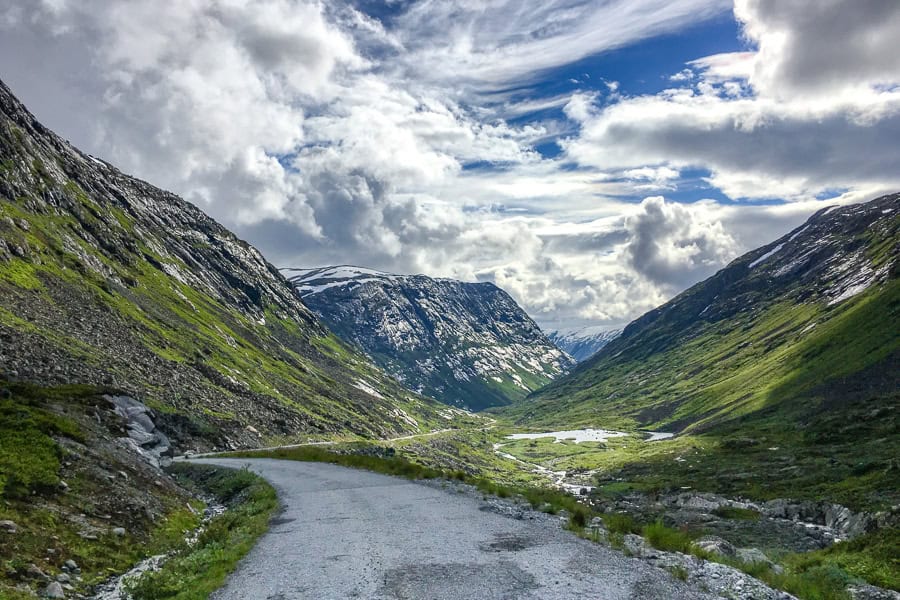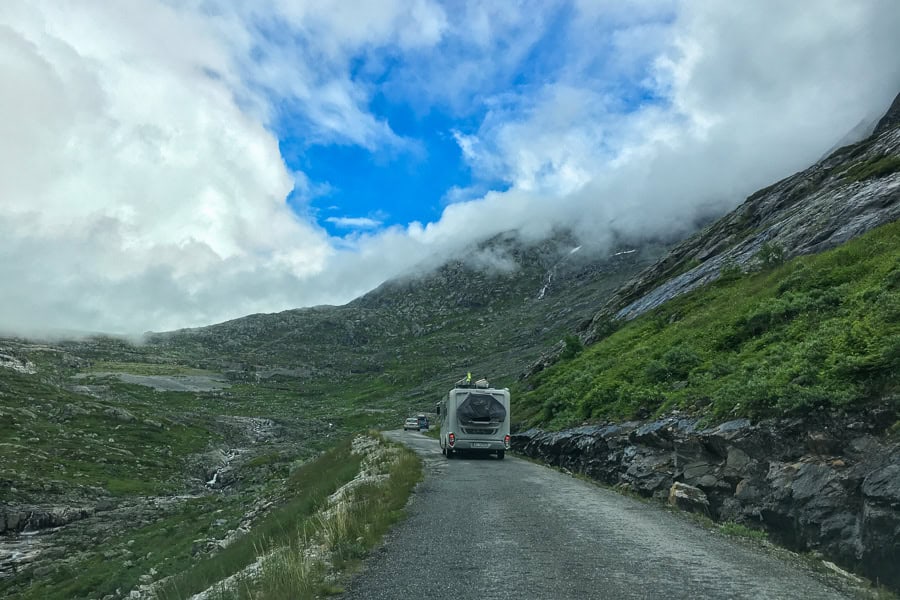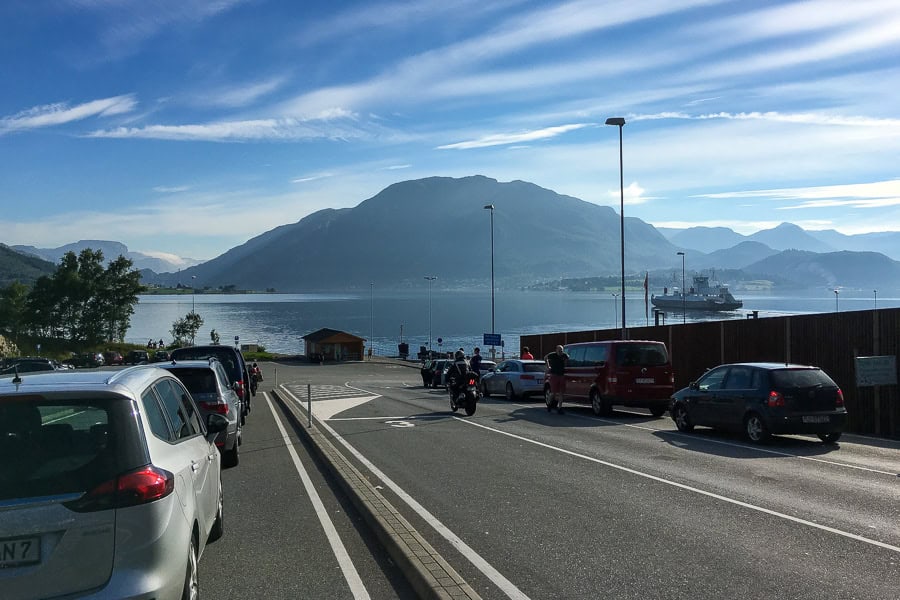If you love road tripping, you’ll love driving in Norway. In this post we outline some of the key things you need to know to get the most out of driving in this incredible country.
Norway is a country chock-full of jaw-dropping, spectacular scenery, and there’s little doubt in our minds that the best way to explore it is by taking to the road.
We’ve travelled Norway by car extensively and loved every minute of driving through the extraordinary landscapes, exploring rugged mountain passes and weaving our way through pristine fjord and coastal scenery.
As European driving experiences go, Norway is a pretty easy place to drive. The road infrastructure, car ferries and signage are all excellent and, for the most part, drivers are safe and considerate.
However, like most places, knowing some of the key local rules and driving conventions in advance of your visit will help to ensure your Norway road trip is a smooth ride and an unforgettable adventure.
What’s in this post?
Getting a Hire Car in Norway
Norway’s Incredible Scenic Routes
Licence Requirements for Driving in Norway
Local Road Rules
Safety Tips
Navigating Around Norway
Norway Road Signs
Speed Cameras in Norway
Toll Roads and Tunnels
Car Ferries in Norway
Parking
Petrol Stations
Electric Vehicles
This post contains affiliate links. If you choose to buy through these links we may earn a small commission at no extra cost to you, which helps us to keep Two for the World running. Many thanks for your support!

Getting a Hire Car in Norway
Unless you’re bringing your own car, you’ll need to arrange a rental car in Norway to get the most out of visiting this dramatic country.
Norway car hire operators will accept most licences that are valid for a year and use the Roman alphabet. However, it’s always worth checking the booking terms and conditions in advance of your visit, as International Driving Permits are required for some nationalities.
We’ve always found the best deals at DiscoverCars and they’re our go-to car hire provider these days. They offer great rates and free cancellation should your plans need to change. It’s always good to book well ahead so you can to lock in the best rates.
Norway’s Incredible Scenic Routes
Norway has some of the most scenic drives on the planet, and 18 of them have been officially recognised as Norwegian Scenic Routes.
These routes are a carefully selected collection of breathtaking drives through mountains and valleys, along fjords and rugged coastline, showcasing the very best of the country’s natural beauty.
Driving some of the Norwegian Scenic Routes was an absolute highlight of our own Norway road trip, which included:
- the incredible Atlantic Ocean Road, a short 8.3 kilometre route that seems to float above the Atlantic Ocean courtesy of a series of dramatic curving bridges;
- the Snow Road (Aurlandsfjellet Scenic Route), which winds its way through snowcapped mountains, scenic valleys, and spectacular viewpoints like Stegastein, sitting 650 metres above Aurlandsfjord; and
- the high-altitude Valdresflye Scenic Route, with its sweeping views of the rugged peaks and tranquil lakes of Jotunheimen National Park.
All 18 scenic routes are truly spectacular, and it’s worth incorporating as many as you can into your Norway road trip itinerary.

Licence Requirements for Driving in Norway
To drive a car in Norway, visitors must be over 18 years of age and hold a valid driving licence from their home country.
If you are visiting from the United Kingdom or a European Union (EU) or European Economic Area (EEA) country, your driving licence is fully recognised in Norway.
If you are visiting from outside the EU/EEA and your licence is in English or Latin script, you can drive in Norway for up to three months.
If your licence is not written in English or Latin script or doesn’t have a photo, you will need an International Driving Permit (IDP) in addition to your home licence to drive in Norway for up to three months.
Local Road Rules
Aside from driving on the right-hand side of the road like most European countries, the road rules for driving in Norway felt quite familiar to us.
In Norway, you must drive on the right side of the road, seat belts and dipped headlights are mandatory, and you overtake to the left.
If your car is a right-hand drive, you will also need to use beam converters on your headlights to avoid blinding other drivers.
Some other key road rules to be aware of are outlined below.
Speed Limits
Speed limits in Norway are generally well signposted and vary depending on where you are. In residential areas, you can expect limits to be as low as 30 km/h, while urban areas are generally 50 km/h, and rural or country roads are usually 80 km/h.
Once you get onto dual carriageways and motorways, the speed limit increases to between 90 and 110 km/h, depending on the road conditions.
Alcohol Limits
Norway has strict drink-driving laws, with a blood alcohol limit of 0.02%, which essentially means you shouldn’t have any alcohol and attempt to drive. Penalties for driving over the alcohol limit are hefty.
Mobile Phones
Using mobile phones while driving in Norway is a big no-no unless you’re using a hands-free system. Avoid touching your phone while driving – even to use maps or play music – if you want to avoid a run-in with the cops.
Travelling as a couple, we always ensure whoever is in the passenger seat looks after navigation and tunes while driving, but if you’re travelling solo, it’s best to pull over somewhere safe to manage your route or music.
Safety Tips
While driving in Norway is fairly straightforward, you do need to exercise caution when driving on the often narrow, winding roads that you’ll find in many rural and mountainous areas.
While we didn’t have any issues ourselves, it’s also good to be aware that wildlife such as elk and reindeer can be a hazard on roads, particularly around dawn and dusk.
Road Conditions
Norway’s spectacular mountain passes and remote wilderness roads are of course one of the big drawcards for a road trip here.
However, it’s worth noting that conditions can change rapidly in Norway, especially in the mountain areas. Some roads close in winter, access to others are very much weather dependent, and sometimes unexpected natural events can throw the best laid plans off course.
For example, during our Norway road trip, we had to significantly rework our itinerary when a landslide closed a road along our planned route for three days.
As such, it’s always advisable to check road conditions and closures before you set off each day.
Snow Tyres
In winter, from November to April, winter tyres (with a tread depth of at least 3mm) are mandatory. It’s also a good idea to carry snow chains if travelling in icy or snowy conditions, and be prepared for sudden weather changes.
Studded tyres can only be used between November and the first Monday after Easter Monday, except in Nordland, Troms and Finnmark where the period is slightly longer.

Safety Equipment for Driving in Norway
Like many European countries, there are a few pieces of safety equipment you are required to carry in your vehicle.
It’s mandatory to have a warning triangle and reflective safety vests, which must be used in the event of a breakdown or accident.
While it’s not mandatory for driving in Norway, we also carry a first aid kit and spare bulbs for our headlights when we road trip, as well as an ice scraper and anti-freeze when travelling in cooler conditions.
Navigating Around Norway
Norway’s road system is categorised with a letter prefix denoting the importance and function of the road.
E-roads (European roads) are international highways that connect major cities across Norway (and Europe). They are marked with green signs and an “E” prefix (eg. E6).
Riksvei (National Roads) have an “R” or “Rv” prefix and link key destinations within Norway, while Fylkesveie (County Roads) are marked with “Fv,” and tend to connect smaller towns and rural areas.
We found navigating in Norway straightforward with apps like Google Maps, Apple Maps and Waze all working well throughout the country.
While mobile network coverage is decent in Norway, there were occasions – particularly in rural and remote areas – where the signal can be patchy, so having offline maps is a must.
We personally downloaded and used offline maps in Google maps for our Norway road trip and it worked pretty well for the most part.
However, to make the best of real-time traffic updates and alternative routes while driving, it’s definitely worth having access to the internet.
As such, getting online using an international eSIM like Airalo will definitely make navigating your trip much easier, especially if you need to change plans on the go in response to weather or road conditions.

Norway Road Signs
Road signs in Norway are easy to understand and categorised into familiar shapes and colours for specific purposes.
Red triangle warning signs are designed to alert drivers to hazards like sharp curves, roadworks, roundabouts or wildlife crossings.
Circular signs with red borders indicate a restriction, such as speed limits, no-entry zones, vehicle size limitations or overtaking restrictions.
Signs with blue circles indicate mandatory requirements for things like direction of travel or turning.
Rectangular information signs provide details of things like road conditions, road type, parking, merged lanes or tourist sites.
You’ll also frequently see signs for tolls or speed camera warnings.
Speed Cameras in Norway
Speed limits in Norway are strictly enforced. Fixed and average speed cameras are widespread and generally preceded by warning signs.
Always follow posted speed limit signs since exceeding limits, even by a small margin, can lead to significant penalties.
And let’s face it, this is Norway, one of the most stunning countries on the planet – you wouldn’t want to zip through it too quickly anyway!
Toll Roads and Tunnels
It’s almost impossible to drive around Norway without encountering toll roads. Many, many toll roads.
While this can add to your trip costs, we reluctantly accepted that the ubiquitous toll roads in Norway are the price you pay for the incredibly well-maintained roads, tunnels and bridges that make road tripping through this spectacular country such a breeze.
Toll Road Tags
Rental cars in Norway will come equipped with an AutoPASS tag so you don’t really have to worry about tolls. You’ll need to budget for toll costs when you return the car, or in some cases a little after, once the toll charges have been finalised.
You have a couple of options to manage tolls if you’re bringing your own car from another country: getting an AutoPASS tag, or registering your vehicle for number plate recognition through EPASS24.
More information on both options is available on the autopass website, but I’ll quickly summarise the main points below.
AutoPASS Tag
To get an AutoPASS tag, you’ll need to register with a toll tag provider in advance, including entering into a user agreement to receive your tag (or applicable device) in the post.
Payment options will depend on the tag provider, however with AutoPASS there are a number of benefits, including a 20% discount on toll roads in Norway, and also being able to use the AutoPASS tag on most ferries with a 10% discount.
EPASS24
With EPASS24, you just need to create an account and register your vehicle’s number plate to be able to pay tolls and other road user charges (like congestion tax) by credit card or invoice.
While EPASS24 is a quicker and simpler system than AutoPASS, it doesn’t include any toll discounts and can’t be used for ferry travel.
Car Ferries in Norway
With an extensive network of fjords carving through the country’s coastline, car ferries and tunnels are a critical link in much of the Norwegian road network. The car ferry system is very well run and easy to use.
Ferry routes and timetables can be found on the Skyss website, while the Bompengekalkulator website has information about pricing using a handy map.
If you have one, your AutoPASS tag will be able to process most ferry charges in Norway.
If you don’t have an AutoPASS tag, your next best option is to sign up to FerryPay. Under this system your number plate will be read as you board the ferry and the credit or debit card registered on your account will be charged for the crossing.
For the most part, regular car ferries in Norway operate on a first come, first served basis and can’t be booked in advance. In summer and other peak periods, it’s advisable to plan ahead, arrive as early as you can, and be prepared for queues.

Parking
Pay attention to local signs when parking in Norway as parking restrictions can vary by day of week, or time of day. We’ve fallen foul of the parking police in Scandinavia before (in Denmark) and received a very hefty fine for our trouble.
That said, we generally didn’t have any issues finding parking in Norway, although we sometimes had to pay, especially in large towns or cities.
In built up areas, we either parked in secure parking garages (P-hus) or found metered street parking zones (P-automat) marked with “P” signs. You can normally pay by card or coin at meters or via a parking app.
Outside the larger towns and cities, we generally found free street parking easily enough.
Petrol Stations
Petrol stations in Norway are widely available, although distances between them can be greater in remote or mountainous regions so plan ahead for longer trips.
Most stations offer petrol and diesel, with biofuel options and EV charging becoming more common, particularly in the larger stations.
Petrol stations will generally accept both cash and card, and many have convenience stores and provide bathroom facilities.
Electric Vehicles in Norway
We certainly noticed a high number of electric vehicles (EVs) on the road in Norway, and that’s not surprising considering Norway now has more EVs on the road than petrol cars.
Norway aims to phase out the sale of fossil fuel-powered cars by 2025, and has made huge strides towards becoming one of the most EV-friendly countries in the world.
EV drivers can expect well developed, extensive EV infrastructure, with a charging network that includes a mix of fast and regular chargers, along with many hotels and shopping centres increasingly offering EV charging facilities.
In addition to abundant charging stations, government incentives make operating an EV more attractive, including reductions in toll, ferry and parking charges in some municipalities.
We hope you found this post helpful. If you’ve got any questions about driving in Norway or have a suggestion to improve this post please drop us a comment below.
If you’re looking for some road tripping inspiration and suggested itineraries, check out our Road Trips page and our bucket list of 100 ultimate road trips around the world.
